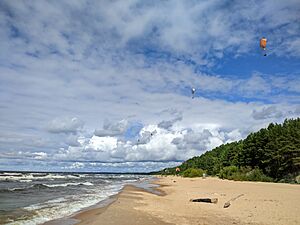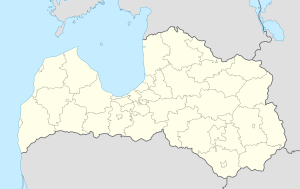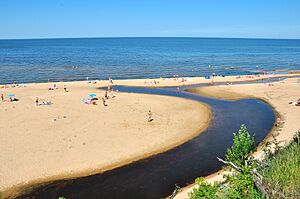Saulkrasti facts for kids
Quick facts for kids
Saulkrasti
|
|||
|---|---|---|---|
|
Town
|
|||

Saulkrasti beach
|
|||
|
|||
| Country | |||
| Municipality | Saulkrasti municipality | ||
| Town rights | 1991 | ||
| Area | |||
| • Total | Lua error in Module:Wd at line 1,575: attempt to index field 'wikibase' (a nil value). km2 (Formatting error: invalid input when rounding sq mi) | ||
| • Land | Lua error in Module:Wd at line 1,575: attempt to index field 'wikibase' (a nil value). km2 (Formatting error: invalid input when rounding sq mi) | ||
| • Water | Expression error: Unexpected < operator. km2 (Formatting error: invalid input when rounding sq mi) | ||
| • Rural territory | 42 km2 (16 sq mi) | ||
| Elevation | 12 m (39 ft) | ||
| Population
(2024)
|
|||
| • Total | 3,149 | ||
| Time zone | UTC+2 (EET) | ||
| • Summer (DST) | UTC+3 (EEST) | ||
| Postal code |
LV-2160
|
||
| Calling code | +371 67 | ||
| Website | http://www.saulkrasti.lv/en/ | ||
Saulkrasti is a town in Latvia. Its name means "Sun shores" in Latvian. It is located on the east coast of the Gulf of Riga.
Saulkrasti was formed from several old fishing villages. The town stretches for about 17 kilometers along the coast. It goes from the Inčupe river in the south to the village of Skulte in the north. The town area is about 4.8 square kilometers. It also includes 42 square kilometers of fields and forests.
The center of Saulkrasti is about 45 kilometers from Riga. Major roads like the European route E67 (Via Baltica) pass through the area. There are six train stations in Saulkrasti and its nearby areas. These stations connect the town to other places by train.
The coat of arms of Saulkrasti has white stripes that show four rivers: Inčupe, Pēterupe, Ķīšupe, and Aģe. The green stripes represent the five villages that came together to form the town. These villages were Bādciems, Katrīnbāde (or Pabaži), Pēterupe, Neibāde, and Zvejniekciems. The top of the coat of arms shows the sea and the sun.
Saulkrasti got its current name in 1933. This was when the five villages joined to become one town. It officially became a town in 1991. Saulkrasti is also known for hosting the yearly Saulkrasti Jazz Festival.
Contents
Discovering Saulkrasti's Location
Saulkrasti is in the Saulkrasti municipality. It is on the southeast side of the Gulf of Riga. The town is about 40 kilometers northeast of Riga. It stretches along a 17-kilometer long coastal forest zone.
The town includes four main populated areas. These are Pabaži, Pēterupe (the city center), Neibāde, and Zvejniekciems. Saulkrasti is next to several other municipalities. These include Carnikava, Ādaži, Sēja, and Limbaži.
The total area of Saulkrasti is about 47.7 square kilometers. About 6 square kilometers are urban areas. The rest is rural territory. In 2008, forests covered about 28.2 square kilometers. About 2.4 square kilometers were used for farming.
A Look at Saulkrasti's Past
Evidence like stone axes shows that people lived in the Saulkrasti area a very long time ago. This was during the newer ice age. The first written records of settlements here are from the Livonian Chronicle of Henry. This area was part of the Livonian lands called Metsopole and Kubesele. Some names today, like Līlaste and Aģe, come from the Livonian language.
After the Baltic Crusades in the 13th century, Saulkrasti became part of the Krimulda parish. Before Saulkrasti became one town, it was part of the Bīriņi parish. The town grew as several villages along the Inčupe, Pēterupe, and Ķīšupe rivers merged.
In 1823, the Neibāde area was formed near the Ķīšupe River. It became a popular spot for noblemen to relax and swim. In 1898, another swimming spot called Katrīnbāde was created. This happened when the Pabaži Manor estate was divided into summerhouse areas. Plans for building the towns of Neibāde and Pēterupe were made in 1920.
How Pēterupe Grew
After World War I, many groups and associations were formed in Latvia. The fishing village of Pēterupe became a center for business and community life. In 1919, the Pētērupe Fishing Association was started. It helped fishermen with their needs.
In 1923, the association moved into a renovated pub. It was renamed Enkurs (meaning "Anchor"). This became a place where fishermen could meet, enjoy shows, and listen to lectures. The association had plans to build a port, but it was never built.
The Story of Neibāde
Neibāde was a quiet summer resort. People from Riga liked it for its peaceful location. A local pub called Āķu krogs (meaning "Hook pub") was a busy spot. It had shops, a meeting room, hairdressers, and a library.
In the 1920s, a cooperative was founded to offer members discounted groceries. This cooperative also held many cultural events. These included a drama club, a choir, and lectures. In 1935, Neibāde was renamed Saulkrasti.
After World War II, Saulkrasti continued to grow. In 1945, Saulkrasti was officially established as a town. Many guesthouses and restaurants were taken over by the state. The town was given worker town rights in 1950.
Building Skulte Port
In the early 1900s, there were not many ports in the Vidzeme region of Latvia. In 1911, officials started looking for a good place to build a port. The mouth of the Aģe river was chosen. It was seen as the best and cheapest place.
After some delays, construction of the port began in 1937. The port was officially opened on October 7, 1939. A fish smoke-house was also built nearby.
Saulkrasti's Development as a Region
In 1950, the "Saulkraste" region was formed. Saulkrasti town became the center of this new region. Many offices and departments were set up in the town hall. This meant that local paperwork could be handled in Saulkrasti instead of Riga.
Public transport was limited after World War II. The railway lines had been destroyed. But on July 3, 1952, the railroad line to Saulkrasti was fixed. It was made electric in 1958.
As the town grew, there was a need for more shops and services. A town market opened in 1950. A regional hospital was opened in 1952.
Saulkrasti also became a center for culture. In 1950, the first Song Festival was held. In 1951, the first Fisherman Day was celebrated. A high school opened in 1950. A new high school building was completed in 1956.
The region, village, and local newspaper were called "Saulkraste" for about two years. In 1952, the name "Saulkrasti" was brought back. In 1957, the Saulkrasti region was dissolved as part of a new reform.
The Growth of the Fishing Industry
Fishing has always been important along the Vidzeme beaches. After 1945, fishermen started forming groups and cooperatives. These groups helped them get tools and improve their fishing methods.
The Skulte fishing port on the Aģe river became very important. Next to the port was the Skulte fish canning factory. This factory was one of the most modern in Vidzeme. It processed fish for all the local fishermen.
The factory grew each year. New equipment and processing lines were added. Canned fish became its main product. These products were sent to many countries around the world. The lives of fishermen also improved. New houses were built, and a large Culture House opened in Zvejniekciems in 1956.
People Living in Saulkrasti
At the start of 2008, there were 6,089 people living in Saulkrasti. About 2,771 of them lived in rural areas. Most residents (82%) are Latvians. About 11% are Russians. The rest are from other countries like Belarus, Poland, Lithuania, and Estonia.
| Saulkrasti population between 1997 and 2008 | |||||||||||||||||||||||||||||||||||||||||||||||
|---|---|---|---|---|---|---|---|---|---|---|---|---|---|---|---|---|---|---|---|---|---|---|---|---|---|---|---|---|---|---|---|---|---|---|---|---|---|---|---|---|---|---|---|---|---|---|---|
|
|
|
|||||||||||||||||||||||||||||||||||||||||||||
Saulkrasti's Economy
Tourism in Saulkrasti
Saulkrasti is a popular place for tourists, especially in the summer. People from Latvia and other countries visit. In 2011, many visitors came from Russia, Germany, Lithuania, Estonia, and Finland. More people are also exploring the city by bicycle.
Skulte Fishing Port's Role
The Skulte fishing port is getting money from European funds. This money is being used to build new piers and warehouses. This will help the port become even better. The goal is to finish all the reconstruction work.
Learning in Saulkrasti
There are several schools in Saulkrasti:
- Saulkrasti high school had 360 students in 2008/2009. It had 38 teachers in 2007/2008.
- Zvejniekciems high school had 395 students in 2008/2009. It had 27 teachers.
- Vidzeme Music and Art school started in 1968. It was first called Zvejniekciems Children Art school. In 1995, it added an Art department. It got its current name in 1997. In 2008, it had 288 students. Students from this school have won awards and shown their art in international exhibitions.
- Pre-school educational establishment "Brownie" is a kindergarten. In 2008, it had 160 children and 22 teachers.
International Connections
Sister Cities
Saulkrasti has a special connection with another town. This is called a "twin town" or "sister city" relationship.
Images for kids
See also
 In Spanish: Saulkrasti para niños
In Spanish: Saulkrasti para niños






